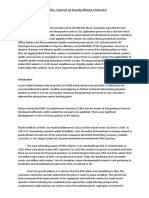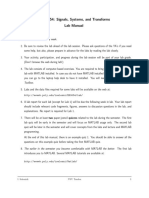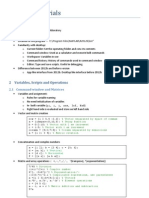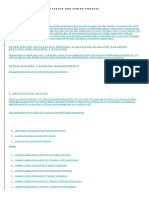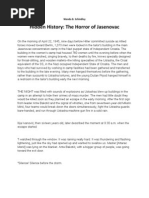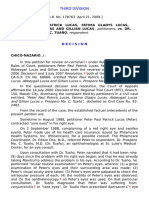0 ratings0% found this document useful (0 votes)
199 viewsIntroduction To DSP Simulations in MATLAB PDF
This lecture introduces digital signal processing (DSP) simulations in MATLAB. It covers basics of MATLAB including the main window, m-files, variables, operations, complex numbers, vectors and matrices. It then discusses 2D graphs including common plotting functions, axes and labels. Outer functions are introduced as m-files that can be called within MATLAB. The lecture concludes by demonstrating discrete signals including sequences, harmonic signals, and functions for max, sum and product of signals.
Uploaded by
ZARGHAM KHANCopyright
© © All Rights Reserved
We take content rights seriously. If you suspect this is your content, claim it here.
Available Formats
Download as PDF, TXT or read online on Scribd
0 ratings0% found this document useful (0 votes)
199 viewsIntroduction To DSP Simulations in MATLAB PDF
This lecture introduces digital signal processing (DSP) simulations in MATLAB. It covers basics of MATLAB including the main window, m-files, variables, operations, complex numbers, vectors and matrices. It then discusses 2D graphs including common plotting functions, axes and labels. Outer functions are introduced as m-files that can be called within MATLAB. The lecture concludes by demonstrating discrete signals including sequences, harmonic signals, and functions for max, sum and product of signals.
Uploaded by
ZARGHAM KHANCopyright
© © All Rights Reserved
We take content rights seriously. If you suspect this is your content, claim it here.
Available Formats
Download as PDF, TXT or read online on Scribd
You are on page 1/ 36
Lecture: Introduction to
DSP simulations in MATLAB
Konstantin Rykov
konstantin.rykov@tut.fi
SGN-1158 Introduction to Signal Processing, short
version
Why youre at this lecture/lab?
Do not fear MATlab. Its your friend
MATlab is a tool
Where I can use MATlab? Examples
Im afraid of program languages
THE MAIN IDEA OF THE LECTURE
11.9.2012 2
ontents
BASICS OF MATLAB
Mainwindow. How to make m-file? How to save m-file?
Some basic hints
Main MATLAB objects (commands, variables)
Main operation symbols
Operation symbols
MATLAB IS AN ADVANCED CALCULATOR
Complex numbers
HELP
Vectors
Matrices
2D GRAPHS
Main MATLAB functions for plotting graphs
General rules of forming graphs
Main tools of staging graphs
Controlling graph properties
LineSpec parameters
OUTER FUNCTIONS IN MATLAB
11.9.2012 3
11.9.2012 4
ontents
DISCRETE SIGNALS IN MATLAB
Sequences
Unit sample sequence, unit step sequence, discrete exp
Discrete complex harmonic signal
Functions max, sum and prod
Generation of signals: rectpuls, tripuls, gauspuls, sinc, square, sawtooth, diric
Functions rand(1,N) and randn(1, N)
TASK: Open MATLAB
The main MATLAB window
11.9.2012 5
BASICS OF MATLAB
Some basic hints
help <name> (for example: >> help cos)
; blocks automatically output of the variables
% makes a comment
to comment a few rows hold Ctrl+R
to uncomment a few rows Ctrl+T
Always use: clc,clear all; close all;
TASK
Type in Editor:
===============
My MATlab Crib
===============
Use CTRL+R to comment it
clc; clear all; close all;
11.9.2012 6
Main MATLAB objects
Commands (clc, help, demo)
Constants (10, -17.28, 5+3j, 1e-6, 10^2)
Standard const (pi, 1i, eps)
Variables MATlab object, which might change its value during
simulation. All variables are MATRIXES in MATlab
Functions (sin(X), exp(X), log10(X), sqrt(X), abs(X),
real(X), imag(X))
Expressions is a sum of constants, functions, variables, which are
summed by operational symbols (x+sin(a)-sqrt(pi);)
11.9.2012 7
Main operation symbols
Symbol Operation
+ Summation
- Difference
* Multiplication of matrixes
.* Multiplication of elements
/ Right division
. Transposing
11.9.2012 8
Complex numbers
11.9.2012 9
MATLAB IS AN ADVANCED
CALCULATOR
Use MATLAB as calculator to find answers
Use help to find what these commands do
abs
angle
exp
conj
11.9.2012 10
Type and simulate
z=3+4i
r=abs(z)
fii=angle(z)
r*exp(i*fii)
zk=conj(z)
z*zk-r^2
What the command format does?
11.9.2012 11
Vectors
Type a=[2 4 5 7] and b=[-1 4 -2 1]
Find a+b, 2*a-2*b
What happens if you type a and b
a*b; a*b; a*b; a*b;
-1:10; 0:2:100; 1:-0.25:-2
Form vectors a=(7,8,9,,22); b=(0,2,4,,100);
c=(100,95,90,,35)
What did you get a(3)? a([3 5 7])? a(3:7)? a(3:end)?
11.9.2012 12
Matries
11.9.2012 13
A=[-7 5 -9; 2 -1 2; 1 -1 2];
Task
Calculate: 3A-5C, 7A+2B, CA, CD
Find out commands: zeros(n), zeros(m,n), ones(n), ones(m,n),
size(D), zeros(size(D)), diag([1 2 3 4]), eye(n)
What happens [A,B] and [A;B]?
Try to find an easy way to build a 7*8-matrix whose other entries are
zeros, but in its diagonal and its last column are 5s
NOTE: Transpose of a matrix is obtained with command
row with A(i,:) and column with A(:,j)
11.9.2012 14
Determine whether the given sets of vectors are linearly
independent/dependent:
W1=[1 2 3], W2=[2 1 5], W3=[-1 2 -4], W4=[0 2 -1]
Use MATLAB to to choose randomly three three column vectors in
The MATLAB commands to choose these vectors are:
y1=rand(3,1)
y2=rand(3,1)
y3=rand(3,1)
HINT check the command rref
11.9.2012 15
2D GRAPHS
Function Meaning
plot (x1, y1, x2, y2,)
Linear graphics
stem
Sequence graphs
stairs
Stairs graphs
loglog
Both Logarithmic axis Im and Re
semilogx
semiloxy
Logarithmic Re axis
Logarithmic Im axis
11.9.2012 16
Main MATLAB functions for plotting graphs
General rules of forming graphs
figure making a new window for a graph
subplot (n,m,p) drawing a few graphs in one window:
n colum, m row, p ordinal number of the graph
hold on plotting another graph at the same picture
hold off
For more information help graph2d
11.9.2012 17
Generate x=[1 20 3 15 18];
Use functions and tell what is the difference:
plot
stem
Generate x1=0:pi/8:8*pi. What we have done? Generate
y(t)=sin(x). Use functions to plot graphs:
plot
stem
stairs
HINT: use command figure or function subplot(n,m,p)
11.9.2012 18
Use semilogx, semilogy, loglog to plot graphs of the following
functions:
1. y=3x^5
2. y=3^(5x-2)
3. y=log10(3x^4)
Use subplot command into 3*3-subplot as described bellow
case (1) semilogx case (1) semilogy case(1) loglog
case (2) semilogx case (2) semilogy case(2) loglog
case (3) semilogx case (3) semilogy case(3) loglog
Consider again y=3x^5. Use plot(x,log10(y)) and compare
its plot with semilogy plot. What is the difference and similarity
between them?
11.9.2012 19
Main tools of staging graphs
Function
grid
title(<text>)
xlabel (<text>)
ylabel (<text>)
Legend (<funct1>,<funct2>,..,Pos)
axis([XMIN XMAX YMIN YMAX])
xlim ([XMIN XMAX])
ylim ([YMIN YMAX])
11.9.2012 20
Pos (-1, 0, 1,,4) TRY THEM!
Generate x1=0:pi/8:8*pi; y1=sin(x1);
Form 3 graph in 1 window.
1
st
graph: plot a discrete signal y(x)
2
nd
graph: plot a discrete signal. Use axis([0 10 -1 1])
3rd graph: do the same, but limit Re axis and Im axis by using
xlim([-15 15]) and ylim([-1.5 1.5])
For all graphs: make a grid, title and give names for both axis
Generate y2=0.5*sin(2*x1);
plot(x1,y1,x1,y2),legend(sin(x1),0.5sin(2x1));
!!!HINT: use hold on!!!
11.9.2012 21
Controlling grpah properies
Each function has different properties.
plot(x1,y1,,LineSpec,PropertyName,PropertyValue,);
stem(x1,y1,,LineSpec,fill,MarkerSize,3);
PropertyName is divided into:
LineWidth line width;
MarkerEdgeColor marker color ;
MarkerFaceColor color by which the marker is filled;
MarkerSize size of the marker , give a value (default - 7).
Let us divide LineSpec parameters into 3 groups: s1, s2, s3.
11.9.2012 22
LineSpec parameters
S1 S2 S3
r Red - +
b Blue : *
g Green -. s Square
w White -- d Diamond
k Black (none) v
y Yellow ^
m Magenta <
c Cyan >
p Pentagram
h Hexagram
11.9.2012 23
Form a vector y = [0 1 2 3 4 5 6 7 8 9]; line width is 2,
use squared black markers, dotted line
x1=0:pi/8:8*pi; y1=sin(x1); - line width 3, dashdot line,
filled green markers, marker size 5
y1=sin(x1); y2=0.2*cos(5x1); - one line is dashed, another
is solid; one line is red, another is green; markers, different sizes
11.9.2012 24
OUTER FUNCTIONS IN MATLAB
Function file is a M-file, which generates outer function
DO NOT PUT ; after function row
After function there is a function body
Put ; everywhere in the body to prevent undesirable output
Good programming means good comments
11.9.2012 25
If you have a few parameters
function [z, p] = F1(x,y)
% Sum of cubes z
% Square root p
z=x.^3+y.^3;
p=sqrt(abs(z));
end
If you have one parameter
function z = F2(x,y)
% Sum of cubes z
z=x.^3+y.^3;
end
After making and saving function-file you can use it in other M-files (script
files).
Actual/Real parameters a=4, b=3, [d,c]=F1(a,b) => saved in
Workspace
Formal parameters 3+5-sqrt(9) => not saved in Workspace
11.9.2012 26
Number of input and output parameters can be formed by commands:
nargin(<function name>)
nargout(<function name>)
Listing of the function is formed by command:
type <name of function-file>
If you need commends of the function file:
help <name of function-file>
If you need to exit compulsory from the body of the outer function use
operator:
return
11.9.2012 27
Let us remake function F1 to F3 with controlling negative argument of
the square root and appropriation p=0 in this case:
function [z, p] = F3(x,y)
% Sum of cubes z
% Square root p
z=x.^3+y.^3;
if z<0
p=0;
return
else
p=sqrt(z);
end
end
11.9.2012 28
DESCRETE SIGNALS IN MATLAB
What is a discrete signal? How does it look like?
How to make a discrete signal:
Matrix x=[0 -1; -4 7; 3 2];
Vector y=[1 20 3 15 18];
Pair of vectors n1=0:12; x1=n.^2;
Vector+Matrix n2=0:2; x2=[0 -1; -4 7; 3 2];
11.9.2012 29
Sequences
11.9.2012 30
1 1.5 2 2.5 3
-5
0
5
10
n
1 2 3 4 5
0
5
10
15
20
n
0 5 10 15
0
50
100
150
n
0 0.5 1 1.5 2
-5
0
5
10
n
Unit sample sequence, unit step sequence, discrete exp,
Form a unit sample sequence, unit step sequence and discrete exp.
The length of the sequence is N=11. Plot graphs.
11.9.2012 31
Discrete complex harmonic signal
is presented as
or , where
Fs=1/T. Real and imaginary parts of x(n) are calculated
by functions real and imag. Absolute value and angle/phase can be
hound with the use of abs and angle
Now, present 32 samples of DCHS x(n), if C=2 and
w=pi/8. Plot real, imaginary parts of the signal.
Present absolute value and the phase of x(n).
11.9.2012 32
Functions max, sum and prod
We can work only with vectors/matrices, which have the same
length/dimentions.
Generate 3 signals x1=(0.8.^n1), x2=cos(w*n2) and
x3=sin(w*n3) with
vector length correspondingly N1=16, N2=24, N3=32 and w=pi/8.
N=max([N1 N2 N3]) to find the maximum value of the vector
length. To add the needed number of zeros to the signal:
y1=[x1 zeros(1, (N-N1))];
Use sum to summate signals and prod to multiply signals. Check
commands if needed in help.
11.9.2012 33
Generation of signals: rectplus, triplus, gausplus, sinc,
square, sawtooth, diric
There is a number of functions for generating signals in the folder
Signal Processing Toolbox.
y=rectpuls(t,w);
y=tripuls(t,w,s);
y=gauspuls(t,fc, bw);
y=sincpuls(t);
y=squarepuls(t,d);
y=sawtoothpuls(t,width);
y=diricpuls(x,N);
11.9.2012 34
Functions rand(1, N) and randn(1, N)
RAND is a uniformly distributed pseudorandom number.
RANDN is a normally distributed pseudorandom numbers.
(1, N) number of rows and columns.
Form additive mixture (sum) of sequence x(n)=sin(wn) with the length N=32
with white noise: uniformly distributed and normally distributed.
11.9.2012 35
Thanks for attention!
Questions?
11.9.2012 36
You might also like
- IB Business Management Exam Questions and Answers P78% (9)IB Business Management Exam Questions and Answers P20 pages
- Amnesty Nigeria DSS Forced Disappearances Report100% (6)Amnesty Nigeria DSS Forced Disappearances Report76 pages
- Quality Control of Ready Mixed Concrete Can Be Divided Into Three Convenient Areas LikeNo ratings yetQuality Control of Ready Mixed Concrete Can Be Divided Into Three Convenient Areas Like15 pages
- Introduction To Matlab & Signals: ObjectiveNo ratings yetIntroduction To Matlab & Signals: Objective7 pages
- Introduction To Matlab& Signals: Defining A ScalarNo ratings yetIntroduction To Matlab& Signals: Defining A Scalar10 pages
- Digital Signal Processing: BY:-Ankit Sharma Roll No: - 0657013108 Btech (It)No ratings yetDigital Signal Processing: BY:-Ankit Sharma Roll No: - 0657013108 Btech (It)33 pages
- Lab 0: Introduction To MATLAB: (LABE 410) Dr. Jad Abou ChaayaNo ratings yetLab 0: Introduction To MATLAB: (LABE 410) Dr. Jad Abou Chaaya6 pages
- Matlab Assignment-01 SEM-II-2016-2017 PDFNo ratings yetMatlab Assignment-01 SEM-II-2016-2017 PDF5 pages
- ECE 3054: Signals, Systems, and Transforms Lab Manual: I. Selesnick NYU TandonNo ratings yetECE 3054: Signals, Systems, and Transforms Lab Manual: I. Selesnick NYU Tandon41 pages
- Lecture Digital Image Processing 2017: Getting StartedNo ratings yetLecture Digital Image Processing 2017: Getting Started9 pages
- Signals and Systems Laboratory 3:: Construction of Signals in MATLABNo ratings yetSignals and Systems Laboratory 3:: Construction of Signals in MATLAB6 pages
- Lab # 2: Basic Operations On Discrete-Time: SequencesNo ratings yetLab # 2: Basic Operations On Discrete-Time: Sequences9 pages
- An Introduction To Matlab: Kocaeli University Assist. Prof. Dr. Osman Büyük Digital Signal Processing ApplicationsNo ratings yetAn Introduction To Matlab: Kocaeli University Assist. Prof. Dr. Osman Büyük Digital Signal Processing Applications37 pages
- Báo - cáo - Nhóm - Tâm - Tài - Trong - (TH tín hiệu và hệ thống)No ratings yetBáo - cáo - Nhóm - Tâm - Tài - Trong - (TH tín hiệu và hệ thống)43 pages
- Quick Introduction To Matlab: Basic Data AnalysisNo ratings yetQuick Introduction To Matlab: Basic Data Analysis10 pages
- A Brief Introduction to MATLAB: Taken From the Book "MATLAB for Beginners: A Gentle Approach"From EverandA Brief Introduction to MATLAB: Taken From the Book "MATLAB for Beginners: A Gentle Approach"2.5/5 (2)
- Graphs with MATLAB (Taken from "MATLAB for Beginners: A Gentle Approach")From EverandGraphs with MATLAB (Taken from "MATLAB for Beginners: A Gentle Approach")4/5 (2)
- Assignment No. 2 Due Date: 15/10/2014 For All StudentsNo ratings yetAssignment No. 2 Due Date: 15/10/2014 For All Students3 pages
- Energy Detectiion of Unknown Deterministic Signals by Harry UrkowitzNo ratings yetEnergy Detectiion of Unknown Deterministic Signals by Harry Urkowitz9 pages
- RTN 950 Product Description (V100R003C03 01)100% (3)RTN 950 Product Description (V100R003C03 01)172 pages
- Light-The Human and The Colourful WorldNo ratings yetLight-The Human and The Colourful World11 pages
- DLL - MAPEH 4 - Q4 - W8 - New@edumaymay@lauramos@angieNo ratings yetDLL - MAPEH 4 - Q4 - W8 - New@edumaymay@lauramos@angie8 pages
- Assessment For Learning For Exam Prep Focus PaperNo ratings yetAssessment For Learning For Exam Prep Focus Paper5 pages
- ISO 9001 Auditing Practices Group: Aligning The QMS With The Achievement of Organizational and Business SuccessNo ratings yetISO 9001 Auditing Practices Group: Aligning The QMS With The Achievement of Organizational and Business Success32 pages
- Summer Enhancement Reading Camp Across The CurriculumNo ratings yetSummer Enhancement Reading Camp Across The Curriculum7 pages
- Baramova - Border Theories in Early Modern Europe PDFNo ratings yetBaramova - Border Theories in Early Modern Europe PDF8 pages
- 2019 Deped Online Application and Hiring ProcessNo ratings yet2019 Deped Online Application and Hiring Process17 pages
- Hidden History The Horror of Jasenovac Wanda B SchindleyNo ratings yetHidden History The Horror of Jasenovac Wanda B Schindley14 pages
- Cytogenetics: Genetics Seek To UnderstandNo ratings yetCytogenetics: Genetics Seek To Understand12 pages
- Lucas v. Tuaño, G.R. No. 178763, April 21, 2009No ratings yetLucas v. Tuaño, G.R. No. 178763, April 21, 200922 pages
- Electrical and Electronic Measurements and InstrumentationNo ratings yetElectrical and Electronic Measurements and Instrumentation12 pages
- CARLOS FERNANDEZ - PST - Module-7 - CareerStage 2 JEL OutputNo ratings yetCARLOS FERNANDEZ - PST - Module-7 - CareerStage 2 JEL Output4 pages
- Air Accessibility and Growth - The Economic Effects of A Capacity Expansion at Vienna International AirportNo ratings yetAir Accessibility and Growth - The Economic Effects of A Capacity Expansion at Vienna International Airport5 pages
- Step-By-Step Plan Exam Task White Paper 1920No ratings yetStep-By-Step Plan Exam Task White Paper 19203 pages
- DTI vs. Enriquez (Jurisdiction Over Presidential Appointees)No ratings yetDTI vs. Enriquez (Jurisdiction Over Presidential Appointees)10 pages




